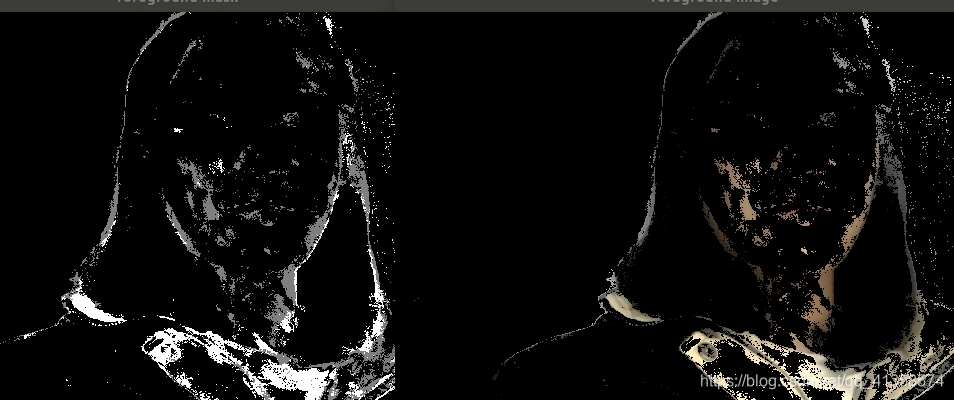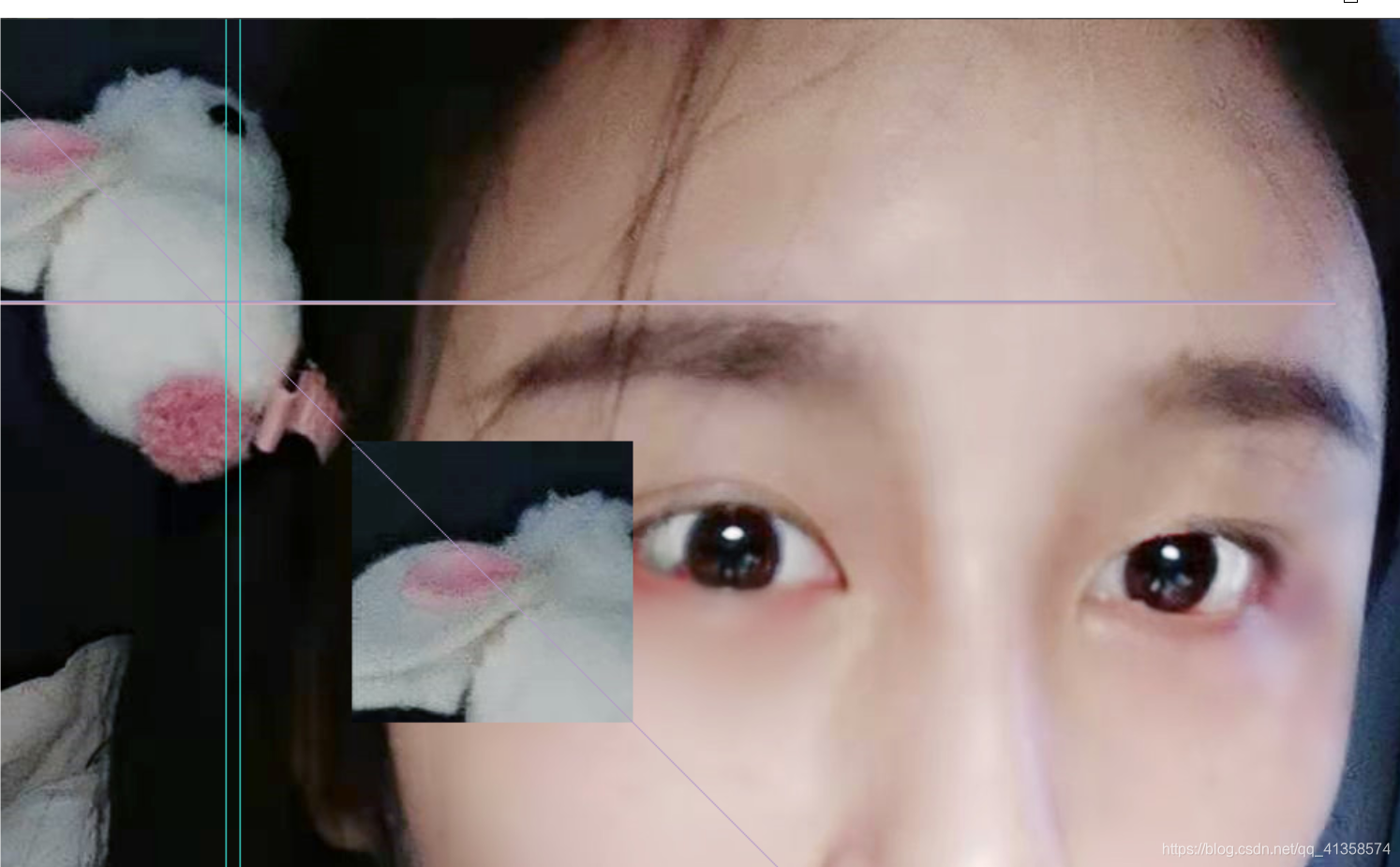概括
从概念上讲,一个字节能表示0到255的整数。目前,对于所有的实时图像应用而言, 虽然有其他的表示形式,但一个像素通常由每个通道的一个字节表示。
一个OpenCV图像是.array类型的二维或三维数组。8位的灰度图像是一个含有字节值 的二维数组。一个24位的BGR图像是一个三维数组,它也包含了字节值。可使用表达式 访问这些值,例如image[0,0]或image[0, 0, 0]。第一个值代表像素的y坐标或行,0表示 顶部;第二个值是像素的x坐标或列,0表示最左边;第三个值(如果可用的话)表示颜色 通道。
C++接口:
1。处理图片
效果:(原图就不发了
 application_trace.cpp
application_trace.cpp
#include <iostream>
#include <opencv2/core.hpp>
#include <opencv2/imgproc.hpp>
#include <opencv2/highgui.hpp>
#include <opencv2/videoio.hpp>
#include <opencv2/core/utils/trace.hpp>
using namespace cv;
using namespace std;
static void process_frame(const cv::UMat& frame)
{
CV_TRACE_FUNCTION(); // OpenCV Trace macro for function
imshow("Live", frame);
UMat gray, processed;
cv::cvtColor(frame, gray, COLOR_BGR2GRAY);
Canny(gray, processed, 32, 64, 3);
imshow("Processed", processed);
}
int main(int argc, char** argv)
{
CV_TRACE_FUNCTION();
cv::CommandLineParser parser(argc, argv,
"{help h ? | | help message}"
"{n | 100 | number of frames to process }"
"{@video | 0 | video filename or cameraID }"
);
if (parser.has("help"))
{
parser.printMessage();
return 0;
}
VideoCapture capture;
std::string video = parser.get<string>("@video");
if (video.size() == 1 && isdigit(video[0]))
capture.open(parser.get<int>("@video"));
else
capture.open(samples::findFileOrKeep(video)); // keep GStreamer pipelines
int nframes = 0;
if (capture.isOpened())
{
nframes = (int)capture.get(CAP_PROP_FRAME_COUNT);
cout << "Video " << video <<
": width=" << capture.get(CAP_PROP_FRAME_WIDTH) <<
", height=" << capture.get(CAP_PROP_FRAME_HEIGHT) <<
", nframes=" << nframes << endl;
}
else
{
cout << "Could not initialize video capturing...\n";
return -1;
}
int N = parser.get<int>("n");
if (nframes > 0 && N > nframes)
N = nframes;
cout << "Start processing..." << endl
<< "Press ESC key to terminate" << endl;
UMat frame;
for (int i = 0; N > 0 ? (i < N) : true; i++)
{
CV_TRACE_REGION("FRAME"); // OpenCV Trace macro for named "scope" region
{
CV_TRACE_REGION("read");
capture.read(frame);
if (frame.empty())
{
cerr << "Can't capture frame: " << i << std::endl;
break;
}
// OpenCV Trace macro for NEXT named region in the same C++ scope
// Previous "read" region will be marked complete on this line.
// Use this to eliminate unnecessary curly braces.
CV_TRACE_REGION_NEXT("process");
process_frame(frame);
CV_TRACE_REGION_NEXT("delay");
if (waitKey(1) == 27/*ESC*/)
break;
}
}
return 0;
}
background segmentation(来自官方示例
#include "opencv2/core.hpp"
#include "opencv2/imgproc.hpp"
#include "opencv2/video.hpp"
#include "opencv2/videoio.hpp"
#include "opencv2/highgui.hpp"
#include <iostream>
using namespace std;
using namespace cv;
int main(int argc, const char** argv)
{
const String keys = "{c camera | 0 | use video stream from camera (device index starting from 0) }"
"{fn file_name | | use video file as input }"
"{m method | mog2 | method: background subtraction algorithm ('knn', 'mog2')}"
"{h help | | show help message}";
CommandLineParser parser(argc, argv, keys);
parser.about("This sample demonstrates background segmentation.");
if (parser.has("help"))
{
parser.printMessage();
return 0;
}
int camera = parser.get<int>("camera");
String file = parser.get<String>("file_name");
String method = parser.get<String>("method");
if (!parser.check())
{
parser.printErrors();
return 1;
}
VideoCapture cap;
if (file.empty())
cap.open(camera);
else
{
file = samples::findFileOrKeep(file); // ignore gstreamer pipelines
cap.open(file.c_str());
}
if (!cap.isOpened())
{
cout << "Can not open video stream: '" << (file.empty() ? "<camera>" : file) << "'" << endl;
return 2;
}
Ptr<BackgroundSubtractor> model;
if (method == "knn")
model = createBackgroundSubtractorKNN();
else if (method == "mog2")
model = createBackgroundSubtractorMOG2();
if (!model)
{
cout << "Can not create background model using provided method: '" << method << "'" << endl;
return 3;
}
cout << "Press <space> to toggle background model update" << endl;
cout << "Press 's' to toggle foreground mask smoothing" << endl;
cout << "Press ESC or 'q' to exit" << endl;
bool doUpdateModel = true;
bool doSmoothMask = false;
Mat inputFrame, frame, foregroundMask, foreground, background;
for (;;)
{
// prepare input frame
cap >> inputFrame;
if (inputFrame.empty())
{
cout << "Finished reading: empty frame" << endl;
break;
}
const Size scaledSize(640, 640 * inputFrame.rows / inputFrame.cols);
resize(inputFrame, frame, scaledSize, 0, 0, INTER_LINEAR);
// pass the frame to background model
model->apply(frame, foregroundMask, doUpdateModel ? -1 : 0);
// show processed frame
imshow("image", frame);
// show foreground image and mask (with optional smoothing)
if (doSmoothMask)
{
GaussianBlur(foregroundMask, foregroundMask, Size(11, 11), 3.5, 3.5);
threshold(foregroundMask, foregroundMask, 10, 255, THRESH_BINARY);
}
if (foreground.empty())
foreground.create(scaledSize, frame.type());
foreground = Scalar::all(0);
frame.copyTo(foreground, foregroundMask);
imshow("foreground mask", foregroundMask);
imshow("foreground image", foreground);
// show background image
model->getBackgroundImage(background);
if (!background.empty())
imshow("mean background image", background );
// interact with user
const char key = (char)waitKey(30);
if (key == 27 || key == 'q') // ESC
{
cout << "Exit requested" << endl;
break;
}
else if (key == ' ')
{
doUpdateModel = !doUpdateModel;
cout << "Toggle background update: " << (doUpdateModel ? "ON" : "OFF") << endl;
}
else if (key == 's')
{
doSmoothMask = !doSmoothMask;
cout << "Toggle foreground mask smoothing: " << (doSmoothMask ? "ON" : "OFF") << endl;
}
}
return 0;
}
效果:

3。腐蚀
#include "opencv2/core.hpp"
#include "opencv2/imgproc.hpp"
#include "opencv2/video.hpp"
#include "opencv2/videoio.hpp"
#include "opencv2/highgui.hpp"
#include"opencv2/imgproc/imgproc.hpp"
#include <iostream>
using namespace std;
using namespace cv;
int main()
{
Mat img = imread("/home/heziyi/图片/7.jpg");
imshow("old",img);
Mat element = getStructuringElement(MORPH_RECT,Size(15,15));
Mat dimg;
erode(img,dimg,element);
imshow("new",dimg);
waitKey(0);
}

4。模糊:
int main()
{
Mat img = imread("/home/heziyi/图片/6.jpg");
imshow("old",img);
Mat element = getStructuringElement(MORPH_RECT,Size(15,15));
Mat dimg;
blur(img,dimg,Size(1,1));
imshow("new",dimg);
waitKey(0);
}
5。边缘检测:
#include "opencv2/core.hpp"
#include "opencv2/imgproc.hpp"
#include "opencv2/video.hpp"
#include "opencv2/videoio.hpp"
#include "opencv2/highgui.hpp"
#include"opencv2/imgproc/imgproc.hpp"
#include <iostream>
using namespace std;
using namespace cv;
int main()
{
Mat img = imread("/home/heziyi/图片/6.jpg");
imshow("old",img);
Mat element = getStructuringElement(MORPH_RECT,Size(15,15));
Mat dimg,edge,grayimg;
dimg.create(img.size(),img.type());
cvtColor(img,grayimg,COLOR_BGRA2GRAY);
blur(grayimg,edge,Size(3,3));
Canny(edge,edge,3,9,3);
imshow("new",edge);
waitKey(0);
}

VideoCapture 提供了摄像机或视频文件捕获视频的C++接口,作用是从视频文件或摄像头捕获视频并显示出来。
//循环显示每一帧
while(1)
{
Mat frame;//用于存储每一帧图像
capture>>frame;
imshow("picture",frame)
waitKey(30);//延时30毫秒
}
python接口:
使用numpy.array访问图像数据
将BGR图像在(0,0)处的像素转化为白 像素。
img[0,0] = [255, 255, 255]
通过三元数组的索引将像素的颜色值设为0
下面的代码可将图像所有的G (绿色)值设为0:
img[:,:,1]=0
cv2.imshow('ppp',img)
cv2.waitKey(30000)

并将第一个区域的值分配给第二个区域(将图 像的一部分拷贝到该图像的另一个位置):
img[y,220]=[z,210,56]
my_roi = img[0:200 , 0:200]
img[300:500, 300:500] = my_roi
cv2.imshow('ppp',img)
cv2.waitKey(30000)
结果:

视频文件的读写
OpenCV提供了 VideoCapture类和VideoWriter类来支持各种格式的视频文件。支持 的格式类型会因系统的不同而变化,但应该都支持AVI格式。在到达视频文件末尾之前, VideoCapture类可通过read()函数来获取新的帧,每帧是一幅基于BGR格式的图像。
可将一幅图像传递给VideoWriter类的write()函数,该函数会将这幅图像加到 VideoWriter类所指向的文件中。下面给出了一个示例,该示例读取AVI文件的帧,并采用 YUV颜色编码将其写入另一个帧中:
import cv2
videoCapture = cv2.VideoCapture(1 MyInputVid.avi1)
fps = videoCapture.get(cv2.CAP_PROP_FPS)
size = (int(videoCapture.get(cv2.CAP_PROP_FRAME_WIDTH)),
int(videoCapture.get(cv2.CAP_PROP_FRAME_HEIGHT)))
videoWriter = cv2.VideoWriter(
'MyOutputVid.avi', cv2.VideoWriter_fourcc('I','4','2','0'),fps,size)
success, frame = videoCapture.read()
while success: # Loop until there are no more frames.
videoWriter.write(frame)
success, frame = videoCapture.read()